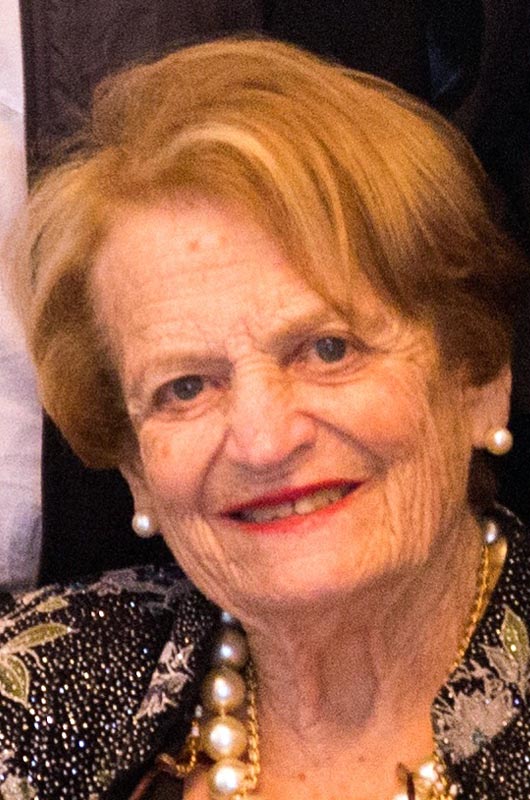Janet L. Wolff, an extraordinary leader and pioneer in the advertising industry, died on July 29 in Pompano Beach, Fla. She was 94 and had been a summer resident on Martha’s Vineyard for 60 years, always mindful of the unique and special beauty of the place and devoted to sharing with her family her love of the Island.
She was born on Feb. 21, 1920, in San Francisco. She grew up in California, attending Castilleja School before moving to New York city as a teenager. In New York she attended Finch Junior College and Toby Coburn where she was among the first women to study fashion and marketing. She moved with her mother to Paris, France, in the mid-thirties where she attended The Sorbonne and many parties. Returning to New York just before World War II, she got her first job at Macy’s. As she said many times to her children and grandchildren, school wasn’t for her; she wanted to be a working girl and a businesswoman. While working at Macy’s she persuaded a junior art director to join her in entering a New York Sun competition for a Father’s Day card to honor fathers returning home from the war. Her tag line, “That’s My Dad,” with pictures of everyday workingmen won the contest, and she was instantly besieged with job offers from many advertising agencies.
In 1945 she married Dr. James Wolff, a pediatrician, and moved to Boston, continuing her career in advertising while her husband completed his fellowship in hematology at Boston Children’s Hospital. After returning to New York city, she worked at J. Walter Thompson Co. for 15 years, becoming its youngest vice president and creative director. At J. Walter Thompson she spearheaded the transition from print and radio campaigns into television for many major advertisers including Ford, Scott Paper and Lever Brothers.
She left J. Walter Thompson to join William Esty Co. in 1965, becoming executive vice president and director of creative services. During this time, William Esty experienced tremendous growth and Mrs. Wolff led many classic campaigns, including Irish Spring, Vaseline Intensive Care, Datsun’s “We are Driven,” and Noxema Shave Cream’s “Take it off, take it all off.”
She was a respected advisor to many company presidents and CEOs and was a leader in new product development and new product positioning. She also blazed a path for women in the field of advertising. When William Esty was sold to Ted Bates Co., she stayed on as executive vice president and creative director. She was inducted into the Advertising Hall of Fame in 1998.
She was the author of eight books. The idea for her first book, What Makes Women Buy (McGraw Hill), came to her during a conversation with a friend on a train ride to work. The book was published in 1958 and opens with the words:
“Whatever you are selling from a bar of soap to a limousine, chances are today’s new woman is in the picture. Either she buys the product herself or she influences the person who does.” Her book chapters “Why women think the way they do?” “What do women really want?” and “What puts women in the buying frame of mind?” became standard reading for business and salespeople who wished to have a deeper understanding of women and their purchasing decisions. Always a visionary, in 1988 she co-authored Lifetrends: The Future of Baby Boomers and Other Aging Americans (Macmillan).
She was one of the first high-powered Madison avenue executives who balanced working full time with raising a family. A nurturing and inspirational mother, she was devoted to her children and protective of her time with them. She was an accomplished equestrian and as a young girl had a horse, Montana Gypsy, which she brought across the country to New York. She was an expert skier and taught all four of her children to love skiing. In her later years on Martha’s Vineyard, she loved playing competitive tennis with her friends and grandchildren. She became an excellent golfer who walked the course into her nineties and had a beautiful, effortless golf swing.
Always looking to innovate, she combined her personal experience as a mother with her ever-present creative energy and interests, co-authoring the Imagication Book Series, published in 1960 by Dutton, designed to teach preschool children how to think imaginatively. She wrote, “the only rules are set by your child’s imagination; a flower may dance; a rabbit fly; ducks may roam the city streets or trains run without tracks.”
She was predeceased by her husband in December 2012. She is survived by her family: James and Carol Wolff of Lincoln; John Wolff and Helle Szkobel-Wolff of San Miguel de Allende, Mexico; Barbara and Mark Amstutz of Swarthmore, Pa.; and Tim Wolff of Ft. Lauderdale, Fla. She had 10 grandchildren: Alex, Kate, Charlie, Jeff, Maddie, Sofie, James, Emmie, Olivia, and Miles.


Comments (10)
Comments
Comment policy »